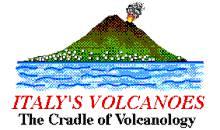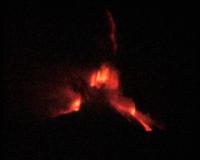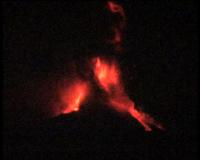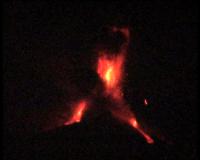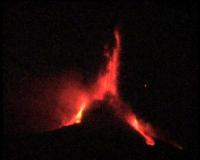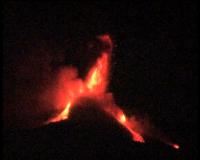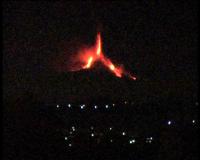|
WARNING:
Access to the summit area is HIGHLY
DANGEROUS. Violent eruptive episodes are occurring
frequently at the Southeast Crater, and heavy showers of tephra
(including clasts tens of centimeters in diameter) may occur
up to several kilometers away. Lava may also arrive rapidly
at up to 1.5 km of distance from the crater. Besides this, weather
conditions are often unstable. Strong wind, snow or rain and
clouds are occuring frequently in the summit area, and one can
get easily lost. Excursions should be made only with the mountain
guides who can be contacted at the cable car (near the Rifugio
Sapienza) on the southern side of Etna, or (during the summer)
at the hotel "Le Betulle" at Piano Provenzana, on
the northern side.
|
27
March 2000 update.
No new eruptive activity has occurred at the Southeast Crater as of
midnight on 26 March, but another paroxysmal eruptive episode will
likely occur within the next 48 hours, if the crater maintains its
rhythm of activity established in the past 4 weeks.
On 25 March, Boris Behncke (Dipartimento di Scienze Geologiche of
the University of Catania) and British cameraman and film maker David
Bryant made an extensive visit to the summit area to survey the effects
of the ongoing eruptions of the SE Crater and some of the changes
caused by the activity of the Bocca Nuova in October-November 1999.
The cone of the SE Crater has grown to unprecedented dimensions. Its
highest point now stands at about 3280 m elevation, almost 100 m higher
than it was three years ago, and only about 30-40 m below the highest
summit of Etna. During the past month it also has grown much broader,
especially on its E side, and it appears that its summit vent is considerably
larger than it was in the first half of February. At its southern
base stands a large knob of lava, with two larger and several smaller
peaks, which is about 30 m high; this is the "Sudestino",
which produced some of the paroxysmal eruptive episodes in mid-March
(especially on the 12th, the 14th and the 19th).
Lava flows from the most recent two eruptive episodes (on 22 and 24
March) were mainly emitted from vents on the upper S flank and on
the lower NE flank of the SE Crater cone. Those emitted by the latter
vents have not yet been surveyed, but on the S side of the cone, lava
has mainly flown past the W side of the "Sudestino", then
turned SW between this vent and the "Observatory cone" (formed
in 1971), to cover a part of the flat terrain to the W and SW of the
latter. From there three tongues of lava have spilled (on 22 March)
onto the relatively steep slope between that flat area and the prehistoric
cone of Monte Frumento Supino. Two flow lobes have almost reached
the N base of this cone, while the westernmost lobe ran about half
way down that distance. The 24 March lava followed the course of the
22 March lava, but extended only slightly beyond the 1971 Observatory
cone. No lava has been emplaced near the building of Torre del Filosofo
since 14 March (on 19 March, lava flows passed about 100-150 m to
the W of the building), and the access road has been reopened to about
50 m below that building. Tourists are now brought to the building
but contained within a small area delimited by a fence at the margin
of the new lava field, which is nearly inaccesible.
The plain to the S of the main summit cone is covered by a thick layer
of scoriae emitted in the past 2 months by the SE Crater. Under that
deposit there still lie several meters of snow. When approaching the
SW side of the main summit cone, Behncke and Bryant found several
large bombs (up to 30 cm in diameter) and two even larger blocks of
altered older rock; these had been ejected on 22 March from the SE
Crater and fallen about 1.5 km to the WSW. Bombs up to 2 m in diameter,
many of which had created spectacular impact craters were found at
a distance of 200-300 m from the SE Crater on the SE rim of the Bocca
Nuova.
Activity in the Bocca Nuova was almost exactly as it had been when
observed on 8 February by Behncke and Scarpinati. Loud emissions of
hot gas occurred at intervals of a few minutes from a vent in the
E part of the crater. These emissions did not eject any fragments
of fresh magmatic rock, and no recent ejecta of this type were seen
around the vent. There is no evidence that there has been anything
like Strombolian activity since the early days of February.
The NW part of the Bocca Nuova, which had last been seen by Behncke
on 1 October 1999 (that is, just before the vigorous activity in that
crater, which culminated in the complete filling of the crater and
spectacular overflows of lava onto the W flank of Etna), is barely
recognizable. A large degassing pit occupies most of that area; this
pit was formed as a result of the collapse of a pyroclastic cone built
during the October-November 1999 eruptions. On the NW side of the
pit, the former rim of the Bocca Nuova had been breached by lava flowing
from underneath a pyroclastic cover, draining the lava lake that had
filled the crater during the activity. The area where this lava had
extruded (probably it had been squeezed out from underneath the growing
pyroclastic cone) had numerous amazing features, such as large extruded
slabs resembling small lava spines and domes. Immediatey to the S
stands a knob which is all that remains of another peculiar feature
formed during the October-November 1999 activity, a large block of
lava and welded scoriae which had been pushed over the rim of the
Bocca Nuova on 25 October 1999. This knob was covered all over by
sulfur sublimates and was criscrossed by numerous cracks which were
incandescent immediately below the surface, and rimmed by beautiful
sublimates ranging in color from orange and yellow to green and turquoise.
Little could be seen of the Voragine, which was filled with dense
vapor, but there was no evidence of recent eruptive activity. However,
there was some kind of activity going on at the Northeast Crater:
while resting at its S base, Behncke and Bryant could hear a whooshing
noise, characteristic of vigorous, possibly explosive, degassing.
This noise was very different from the loud roaring noises caused
by degassing deep within the central pit of that crater during June-September
1999. The NE Crater had been the site of vigorous Strombolian activity
in late-September to early October 1999 but had been quiet since then.
The observations made on 26 March indicate that almost all eruptive
activity at Etna is presently confined to the SE Crater, which will
probably continue to produce violent, short-lived eruptive episodes
for some time.
24
March 2000 update.
Exactly two days after its previous eruptive episode, the Southeast
Crater produced another spectacular eruptive episode, which was in
many respects similar to its predecessor. The activity initiated with
lava outflow on the NE flank of the SE Crater cone after nightfall,
and gradually gained in strength until, at about 1945 h (local time=GMT+1),
lava fountains began jetting from the summit vent of the crater. Giuseppe
Scarpinati observed from his home in Acireale that before the lava
fountain appeared at the summit vent, a lava fountain had developed
at the effusive vent on the NE side of the SE Crater cone, and then
an intermittent glow appeared at its summit vent, which probably resulted
from weak Strombolian activity. The lava fountain gained in vigor
around 2000 h and continued strongly until about 2040 h. During this
period, loud prolonged rumbling sounds could be heard above the traffic
noise in Catania, and windows vibrated in Acireale and other towns
closer to the volcano. Scarpinati remarked that this was a much louder
eruptive episode than the previous one, which hardly produced any
noise audible at Acireale.
Lava flowed vigorously from the NE vents into the Valle del Bove,
bifurcating into numerous lobes, the longest of which reached a length
of more than 1 km from their source. On the SSW flank, the vent, which
had already erupted two days before, reactivated and produced a modest
lava flow. By 2100 the paroxysmal phase of the eruptive episode was
over, but lava continued to flow vigorously from the NE vents, accompanied
by mild spattering, and had not ceased as this update was posted (shortly
before midnight on 24 March).
22
March 2000 update.
The following is based on visual observations made by Behncke from
Catania, by David Bryant from Cannizzaro, NE of Catania, and by Giuseppe
Scarpinati from Acireale, N of Catania. The text has been slightly
modified on 23 March.
Three and a half days after the latest eruptive episode from the "Sudestino"
on the southern flank of the Southeast Crater cone, the main vent
of the Southeast Crater began erupting in the late afternoon o 22
March. By 1945 h (local time=GMT+1), the activity, which had initially
consisted of mild Strombolian bursts, had gradually developed into
a near continuous fountain. Shorty after 2000 h, a new vent burst
open high on the SSW flank of the SE Crater cone, and soon lava began
to flow from this vent. Sometime around 2025 h, eruptive activity
began from vents at the northeastern (or eastern) base of the cone,
producing a spectacular lava fountain a few tens of meters high, and
a lava flow that formed two lobes into the Valle del Bove. The main
fountain at the summit of the SE Crater cone at this time was about
300 m high, with some brief jets rising even higher, but began to
decrease a few minutes later and ceased shortly before 2100 h; lava
continued to flow from the flank vents for some time thereafter. The
flow from the SSW flank fissure apparently turned sharply to the W
and thus the Torre del Filosofo building was not threatened. It seems
that this flow reached a length of up to 1.5 km and turned to the
SW near Monte Frumento Supino. The other flow, which was fed by the
NE (or E) vents, ran down into the Valle del Bove probably to the
E and SE, and was possibly longer than the flow from the SSW flank
vents. The wind direction was to the SW, so that any tephra falls
are expected to have occurred in the area between the towns of Paternò
and Adrano. By about 2220 h, very mild eruptive activity was continuing
at the NE (or E) vent and possibly near the summit of the SE Crater
cone, and lava flows kept advancing to the SSW and E.
This latest eruptive episode - the 43rd in two months - apparently
marked a return to conditions similar to those prevailing in early
to mid-February, when the most vigorous activity occurred at the summit
vent of the SE Crater, but lava was erupted from vents that opened
on the S and N flanks of its cone. The duration of this event, however,
was longer than most paroxysms of that period when eruptive episodes
occurred at a rate of 2-3 per day. It is also interesting that no
activity occurred at the "Sudestino" which had been the
main vent of the last few eruptive episodes.
19
March 2000 update.
After almost five days of quiescence, a new eruptive episode occurred
at the "Sudestino" vent of the Southeast Crater during the
early morning hours of 19 March. The activity was visible from Catania
at about 01:30 h (local time=GMT+1) in spite of very bad weather,
when a gap opened in the low clouds. At that time, a broad fountain
was seen jetting from the vent, and lava had begun to extend down
the flanks of the "Sudestino" cone. The activity probably
lasted until about 0300 h, by which time the fountaining activity
was essentially over, but lava continued to advance on the flat area
to the southwest of the eruptive vent, slightly to the west of the
Torre del Filosofo building, which had been encircled by lava on 14
March. It is not known whether any lava has reached the building this
time, but is appears that most lava went in other directions.
At the height of the activity, the fountain from the "Sudestino"
rose 150-200 m high, but decreased later to a few tens of meters in
height. There was also significant ash emission - maybe from the crater
lying slightly above the "Sudestino" on the lower south
flank of the SE Crater cone - as evident from a light rain of ash
that fell over Catania and surrounding areas during the early morning
hours. The time of the ash fall must have been considerably later
than 0200 h, since by that time it was still raining, but the ash
fell when most water on cars had already dried up.
When day broke, lava was still advancing on the slope below the plain
south of the summit cone complex, and dense whitish fume continued
to rise from the "Sudestino" vent as of noon on 19 March.
16
March 2000 update.
Boris Behncke (Dipartimento di Scienze Geologiche of the University
of Catania) and British cameraman and film maker David Bryant visited
the summit area of Etna on 16 March to document the effects of the
recent eruptive activity at the Southeast Crater. They were accompanied
by a small group of students from France, Spain and the UK. No eruptive
activity occurred during the several hours of their ascent and stay
at the Torre del Filosofo building.
Lava from the latest episode of eruptive activity at the SE Crater
- or, rather, from vents on its lower southern flank - has reached
and nearly encircled the Torre del Filosofo building, and piled up
nearly to its roof on the northern side. Only the southern and eastern
sides of the building are still accessible at ground height. Miraculously
the entrance to the cellar of the building is still accessible, although
the lava has burned the wooden shack which stood in front of it, and
which had been used by the Etna mountain guides for the sale of souvenirs
and drinks. While the group was approaching towards the building,
the last bits of scientific and communication equipment (antennae
and solar panels) were removed from the building; a new road had been
dug by a carterpillar into the most recent lava up to about 100 m
away to allow transport of the equipment.
The building presents a pitiful sight - even more pitiful than it
was for many years before. It had definitely not been one of Sicily's
architectural masterpieces, but it had given comfort and shelter during
bad weather and eruptions; now this may soon vanish in a new assault
of lava. The rapid snowmelt - maybe in part caused by the burning
of the wooden shack, which had been covered to its roof by snow until
Saturday - had generated a small flash flood on the eastern side of
the building, where a deep ravine was eroded into the unconsolidated
ground, exposing older tephra deposits, and, on top of them, a stratum
of litter produced during construction of the building in the late-1960s.
Below this ravine, which was up to 3 m deep, a peculiar yellowish
gray lahar deposit was formed, extending about 100 m down the slope
to the south. The deposit contained gravel and blocks up to 0.5 m
in diameter.
It appears that the destruction of the guides' shack only occurred
as late as on 14 March, not, as previously indicated, during the 12
March eruptive episode. Observers of the eruptive episode of 14 March
reported that at the time of their observations, they noted "no
lava near the Torre del Filosofo", and saw the wooden shack exactly
as Behncke had seen it during his previous visit, on 11 March: buried
almost completely by snow, with only a small portion of the roof protruding.
This detail is interesting, because the shack had been reported "burnt
by the lava" already on 12 March, and that same day lava had
reportedly touched the main Torre del Filosofo building on its northern
and western sides (source of the latter piece of information: weekly
bulletin of the Poseidon monitoring
network, 13 March 2000, where no reference to the guides' shack
is made).
During the most recent eruptive episodes - the latest had occurred
on Sunday 12 March and Tuesday 14 March - most activity had occurred
not from the summit vent of the Southeast Crater itself, but from
vents on the lower southern flank of its cone. Photos taken by mountain
guides during the eruptive episode of 12 March show that a dark ash
plume originated from a crater about two-thirds down the southern
flank of the cone, while a broad lava fountain was erupted from a
vent still further downslope, where a new lava shield crowned by a
small cone has formed. Most if not all of the lava came from this
latter vent, which appears to have become the principal eruptive vent,
and which will be from here on named "Sudestino" (little
Southeast - in agreement with the famous "Nordestino", a
small cone that formed adjacent to the Northeast Crater in the late-1960s;
the name "Sudestino" has been proposed first by Marco Fulle
of Stromboli On-line and has been accepted by the makers of both Stromboli
On-line and "Italy's Volcanoes", but it is also being used
by the Etnean mountain guides). Since Behncke's previous visit to
the Torre del Filosofo area on Saturday 11 March, the "Sudestino"
has grown significantly and assumed a more pointed shape, whereas
the larger crater - source of the ash emissions during the 12 March
eruptive episode - is similar to how it was like during the past few
weeks, without much of a cone around it. Both vents are only about
600 m away from the Torre del Filosofo building, and it is well possible
that the next eruptive episodes will deliver more lava in its direction,
which will inevitably cause the burial of the building.
If
the more recent eruptive episodes are compared to those of early to
mid-February, a number of significant changes are to be noted.
1) The intervals between the episodes are longer than about one month
earlier. While in mid-February there were up to three episodes in
one day, the intervals are now lasting several days (maximum: 4 days).
2) The eruptive episodes are less violent now than one month ago.
In mid-February, fire fountains often jetted to heights of 300-500
m and even higher, as in the case of the 15 February paroxysm. The
lava fountains from the "Sudestino" on 12 March were at
best 100 m high.
3) The culminating phases of the episodes now last longer than those
of the earlier ones - more than one hour compared to only 10 minutes.
Similarly, the buildup of the activity extends over periods of many
hours, while in February the buildup - from increased gas emission
to the establishment of a continuous gas and magma jet - often lasted
only 15-30 minutes.
4) Most eruptive activity during the latest episodes was concentrated
at the "Sudestino", while the main vent of the Southeast
Crater produced relatively little activity and no lava effusion. There
is not much known about the vents on the northern flank of the SE
Crater cone, but it appears that they are less significant in the
recent activity than in early to mid-February.
5) The latest eruptive episodes have produced a significant volume
of lava on the southern side of the SE Crater, with much longer flows
than their predecessors. Lava flows of the latest two episodes have
advanced up to 1.5 km from the summit of the SE Crater (almost 1 km
from their source vent) and covered a broad terrain to the south of
the SE Crater.
What are
the prospects for the near future? Eruptive episodes will likely continue
from the Southeast Crater and its new vents. Lava will continue to
spill from these vents over the gently sloping plain south of them,
and some flows may reach the Torre del Filosofo again. If the lava
tightens its deadly grip, the building will eventually be buried -
not crushed - by the lava, and the only structure offering shelter
will be lost. During the impending summer season - regular guided
tours by cable car and jeeps will be resumed early next week - tourists
might no longer be transported to the building, either because it
will no longer be there or because of the risk from the ongoing activity.
"We'll bring them as far as we can", one guide said today,
"certainly respecting the limits of safety." For the moment,
the only safe place from which relatively good views of the summit
craters can be obtained is the "Belvedere", on the rim of
the Valle del Bove, about 2.5 km SSE of the SE Crater.
Several
other web pages covering the recent and ongoing eruptions of the Southeast
Crater are now available; these contain photos and movie clips of
some of the most spectacular moments of that period.
Extremely
spectacular video clips, taken by British cameraman and film maker
David Bryant on 15 February 2000
At
"Italy's Volcanoes" -
At Stromboli On-line
Photos
of the eruptive activity, 15-23 February 2000, by Tom Pfeiffer (University
of Arhus, Denmark)
Photos
of the 15 February 2000 paroxysm of the SE Crater, by Thorsten Boeckel,
Germany
Photos
by Marco Fulle, 15-20 February 2000, at Stromboli On-line - very high
quality, as usual
Charles
Rivière's Etna home page, with many photos (the most recent
of March 2000), updates, and other, highly interesting items (in French
and English)
